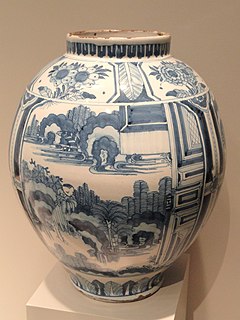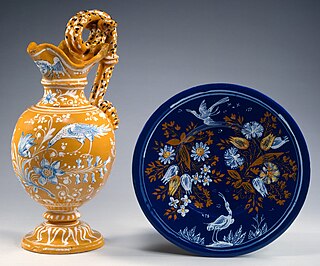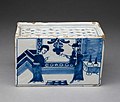
Delftware or Delft pottery, also known as Delft Blue, is a general term now used for Dutch tin-glazed earthenware, a form of faience. Most of it is blue and white pottery, and the city of Delft in the Netherlands was the major centre of production, but the term covers wares with other colours, and made elsewhere. It is also used for similar pottery, English delftware.

Earthenware is glazed or unglazed nonvitreous pottery that has normally been fired below 1,200 °C (2,190 °F). Basic earthenware, often called terracotta, absorbs liquids such as water. However, earthenware can be made impervious to liquids by coating it with a ceramic glaze, which the great majority of modern domestic earthenware has. The main other important types of pottery are porcelain, bone china, and stoneware, all fired at high enough temperatures to vitrify.

Faience or faïence is the general English language term for fine tin-glazed pottery. The invention of a white pottery glaze suitable for painted decoration, by the addition of an oxide of tin to the slip of a lead glaze, was a major advance in the history of pottery. The invention seems to have been made in Iran or the Middle East before the ninth century. A kiln capable of producing temperatures exceeding 1,000 °C (1,830 °F) was required to achieve this result, the result of millennia of refined pottery-making traditions. The term is now used for a wide variety of pottery from several parts of the world, including many types of European painted wares, often produced as cheaper versions of porcelain styles.

A vase is an open container. It can be made from a number of materials, such as ceramics, glass, non-rusting metals, such as aluminium, brass, bronze, or stainless steel. Even wood has been used to make vases, either by using tree species that naturally resist rot, such as teak, or by applying a protective coating to conventional wood or plastic. Vases are often decorated, and they are often used to hold cut flowers. Vases come in different sizes to support whatever flower it is holding or keeping in place.

English delftware is tin-glazed pottery made in the British Isles between about 1550 and the late 18th century. The main centres of production were London, Bristol and Liverpool with smaller centres at Wincanton, Glasgow and Dublin. English tin-glazed pottery was called "galleyware" or "galliware" and its makers "gallypotters" until the early 18th century; it was given the name delftware after the tin-glazed pottery from the Netherlands,

Creamware is a cream-coloured refined earthenware with a lead glaze over a pale body, known in France as faïence fine, in the Netherlands as Engels porselein, and in Italy as terraglia inglese. It was created about 1750 by the potters of Staffordshire, England, who refined the materials and techniques of salt-glazed earthenware towards a finer, thinner, whiter body with a brilliant glassy lead glaze, which proved so ideal for domestic ware that it supplanted white salt-glaze wares by about 1780. It was popular until the 1840s.

In different periods of time and in different countries the word majolica has been used for two distinct types of pottery.

"Blue and white pottery" covers a wide range of white pottery and porcelain decorated under the glaze with a blue pigment, generally cobalt oxide. The decoration is commonly applied by hand, originally by brush painting, but nowadays by stencilling or by transfer-printing, though other methods of application have also been used. The cobalt pigment is one of the very few that can withstand the highest firing temperatures that are required, in particular for porcelain, which partly accounts for its long-lasting popularity. Historically, many other colours required overglaze decoration and then a second firing at a lower temperature to fix that.

Maiolica is tin-glazed pottery decorated in colours on a white background. Italian maiolica dating from the Renaissance period is the most renowned. When depicting historical and mythical scenes, these works were known as istoriato wares. By the late 15th century, multiple locations, mainly in northern and central Italy, were producing sophisticated pieces for a luxury market in Italy and beyond. In France maiolica developed as faience, in the Netherlands and England as delftware, and in Spain as talavera. In English the spelling was anglicised to majolica but the pronunciation usually preserved the vowel with an i as in kite.

Tin-glazing is the process of giving tin-glazed pottery items a ceramic glaze that is white, glossy and opaque, which is normally applied to red or buff earthenware. Tin-glaze is plain lead glaze with a small amount of tin oxide added. The opacity and whiteness of tin glaze encourage its frequent decoration. Historically this has mostly been done before the single firing, when the colours blend into the glaze, but since the 17th century also using overglaze enamels, with a light second firing, allowing a wider range of colours. Majolica, maiolica, delftware and faience are among the terms used for common types of tin-glazed pottery.

Liverpool porcelain is mostly of the soft-paste porcelain type and was produced between about 1754 and 1804 in various factories in Liverpool. Tin-glazed English delftware had been produced in Liverpool from at least 1710 at numerous potteries, but some then switched to making porcelain. A portion of the output was exported, mainly to North America and the Caribbean.

Mintons was a major company in Staffordshire pottery, "Europe's leading ceramic factory during the Victorian era", an independent business from 1793 to 1968. It was a leader in ceramic design, working in a number of different ceramic bodies, decorative techniques, and "a glorious pot-pourri of styles - Rococo shapes with Oriental motifs, Classical shapes with Medieval designs and Art Nouveau borders were among the many wonderful concoctions". As well as pottery vessels and sculptures, the firm was a leading manufacturer of tiles and other architectural ceramics, producing work for both the Houses of Parliament and United States Capitol.

Ceramic glaze is an impervious layer or coating of a vitreous substance which has been fused to a pottery body through firing. Glaze can serve to color, decorate or waterproof an item. Glazing renders earthenware vessels suitable for holding liquids, sealing the inherent porosity of unglazed biscuit earthenware. It also gives a tougher surface. Glaze is also used on stoneware and porcelain. In addition to their functionality, glazes can form a variety of surface finishes, including degrees of glossy or matte finish and color. Glazes may also enhance the underlying design or texture either unmodified or inscribed, carved or painted.

Victorian majolica properly refers to two types of majolica made in the second half of the 19th century in Europe and America.

Tin-glazed pottery is earthenware covered in lead glaze with added tin oxide which is white, shiny and opaque ; usually this provides a background for brightly painted decoration. It has been important in Islamic and European pottery, but very little used in East Asia. The pottery body is usually made of red or buff-colored earthenware and the white glaze imitated Chinese porcelain. The decoration on tin-glazed pottery is usually applied to the unfired glaze surface by brush with metallic oxides, commonly cobalt oxide, copper oxide, iron oxide, manganese dioxide and antimony oxide. The makers of Italian tin-glazed pottery from the late Renaissance blended oxides to produce detailed and realistic polychrome paintings.

The city of Nevers, Nièvre, now in the Bourgogne-Franche-Comté region in central France, was a centre for manufacturing faience, or tin-glazed earthenware pottery, between around 1580 and the early 19th century. Production of Nevers faience then gradually died down to a single factory, before a revival in the 1880s. In 2017, there were still two potteries making it in the city, after a third had closed. However the quality and prestige of the wares has gradually declined, from a fashionable luxury product for the court, to a traditional regional speciality using styles derived from the past.

China painting, or porcelain painting, is the decoration of glazed porcelain objects such as plates, bowls, vases or statues. The body of the object may be hard-paste porcelain, developed in China in the 7th or 8th century, or soft-paste porcelain, developed in 18th-century Europe. The broader term ceramic painting includes painted decoration on lead-glazed earthenware such as creamware or tin-glazed pottery such as maiolica or faience.

Ceramic art is art made from ceramic materials, including clay. It may take forms including artistic pottery, including tableware, tiles, figurines and other sculpture. As one of the plastic arts, ceramic art is one of the visual arts. While some ceramics are considered fine art, such as pottery or sculpture, most are considered to be decorative, industrial or applied art objects. Ceramics may also be considered artefacts in archaeology. Ceramic art can be made by one person or by a group of people. In a pottery or ceramic factory, a group of people design, manufacture and decorate the art ware. Products from a pottery are sometimes referred to as "art pottery". In a one-person pottery studio, ceramists or potters produce studio pottery.

The Flower-holder (Tulpenvaas) is one of a matching pair of tulip vases dated to ca. 1690 and currently in the collection of Museum Het Prinsenhof.

Staffordshire figures are a type of popular pottery figurine made in England from the 18th century onward. Most Staffordshire figures made from 1740 to 1900 were produced by small potteries and makers' marks are generally absent. Most Victorian figures were designed to stand on a shelf or mantlepiece and are therefore only modelled and decorated where visible from the front and sides. These are known as 'flatbacks'.





















